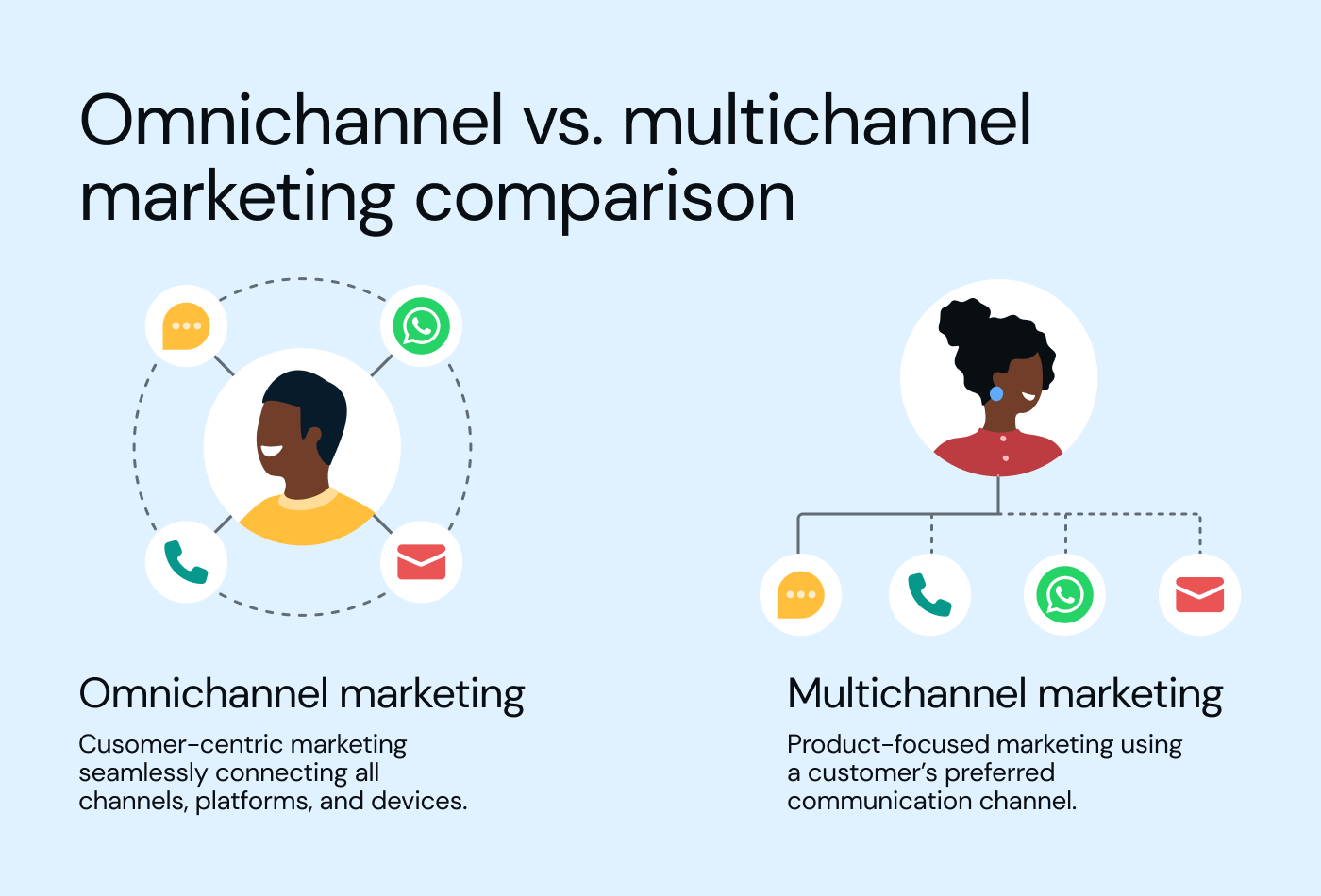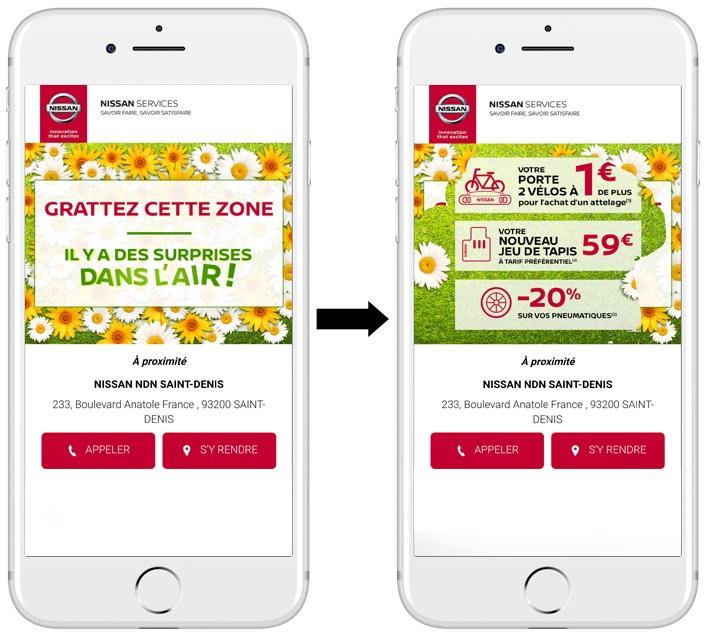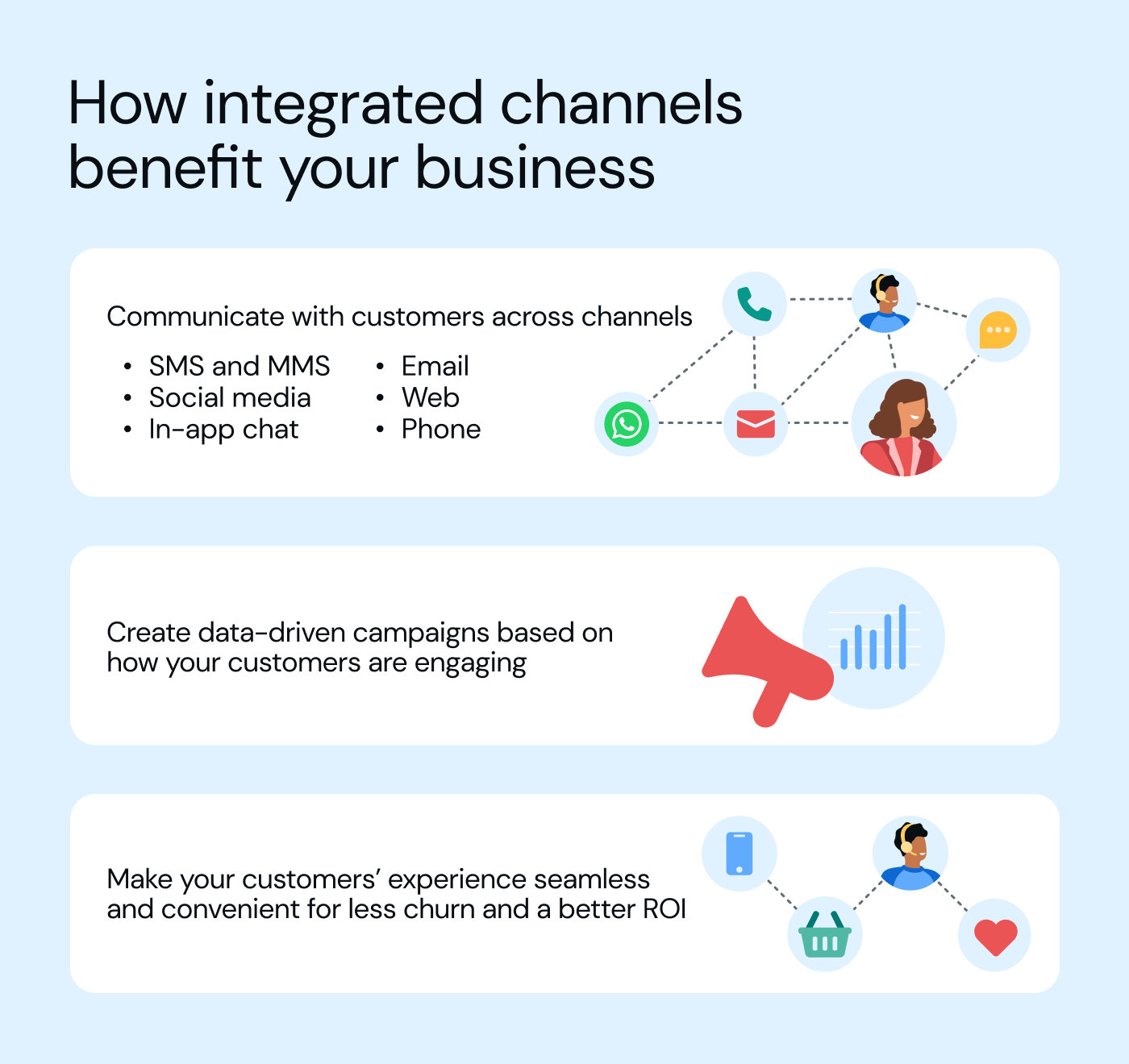In this article:
- What is multichannel?
- How does multichannel marketing work?
- What is omnichannel?
- How does omnichannel marketing work?
- Comparing omnichannel vs multichannel marketing
- Multichannel vs omnichannel examples
- Omnichannel vs multichannel: when to choose
- What are the benefits of an omnichannel marketing strategy?
- How do omnichannel vs. multichannel strategies impact customer experience?
- How to choose the right strategy for your business
In today’s world, people expect everything to be easy to access on their phones. Convenience is no longer a luxury, but a necessity. The pandemic has sped up the move to online shopping, forcing brands to rethink their plans or risk losing to competitors. To keep up, successful brands have prioritized providing seamless multichannel and omnichannel experiences to meet this heightened demand and keep their communications conversational.
While adapting to change, many people may wonder: What’s the real difference between a multichannel and omnichannel strategy?
If you want to put your customers first and make more informed, data-driven decisions about your marketing efforts, you have to understand these two strategies. Let’s dive into some key differences between multichannel and omnichannel marketing to better navigate your strategy.
What is multichannel?
Multichannel marketing uses different online and offline media channels to talk to customers and potential prospects. These channels can be through messaging, TV, print, social media, voice, in stores, email, billboards, etc.
Note that these individual channels operates independently, so customers must visit that specific channel to find the information they need. Messages between channels may not be synchronized.
When it comes to customer engagement, multichannel focuses on reaching customers on their preferred channel. The goal is to offer personalized information that promotes a brand’s products.
Pros of multichannel
-
You can reach customers where they are.
-
You can take advantage of the benefits of different messaging and communication channels.
Cons of multichannel
-
Multichannel strategies tend to be product-focused, meaning they prioritize promoting specific products or services.
-
If you’re a retailer, it can be difficult to keep track of all the orders if they come from multiple channels. So, you might need to find a way to automate the process.
-
It may be difficult to track and measure performance.
How does multichannel marketing work?
Multichannel marketing means using various channels like email, SMS, display ads, TV, and print to connect with customers. While it expands your company’s reach, each channel operates independently. For example, the content and style of your LinkedIn ad might be completely different than your promotional SMS.
Put another way, if a customer chooses one channel to hear from you and then switches to another, it’s like beginning a new conversation. This could be frustrating as they might need to repeat information or guess about past conversations with your company.
To make multichannel marketing work well, you should use the strengths of each channel to make sure they all work towards the same goal. This means customizing content and messages to fit each platform’s style. We’ll give some examples of this later on.
What is omnichannel?
Like multichannel, omnichannel also involves multiple channels for customer engagement. However, unlike multichannel strategies where channels operate independently, omnichannel marketing integrates these channels to create a unified, customer-centric experience. This integration can allow for better tracking and attribution of customer interactions across various touchpoints.
With an omnichannel strategy, you can keep tabs on customers everywhere they interact with you. This can help you make personalized marketing campaigns using their purchases and data.
The result? Increased engagement, improved customer loyalty, and higher customer retention.
Pros of omnichannel
- You can be customer centric.
- Offers flexible communication options.
- There’s a seamless transition between channels.
- It’s easily scalable to accommodate business growth.
Cons of omnichannel
-
It may require significant investment in technology and infrastructure.
How does omnichannel marketing work?
Omnichannel marketing creates a smooth customer journey by blending branding, messaging, and touchpoints across all online and offline channels. It ensures a smooth flow as consumers navigate through various channels, platforms, and devices.
Today, consumers interact with brands in many different ways, from social media channels to calling customer service. Omnichannel marketing prioritizes the customer, aiming for a positive and consistent experience across all channels. Any distinctions between channels become irrelevant from the customer’s perspective.
From a business’ perspective, omnichannel removes boundaries between different sales and marketing channels, creating a unified, integrated approach.
Comparing omnichannel vs multichannel marketing
Multichannel and omnichannel strategies both let people interact with a brand on many channels. The two differ when a customer wants to move across two or more channels.
In essence, omnichannel marketing has the customer at the center. With an omnichannel strategy, you’re creating a smooth path for customers to interact with your brand, from initial engagement, to purchase, to support across multiple channels.
Let’s take a look at what this might look like from a customer’s perspective: Imagine you’re shopping for running shoes online. In an omnichannel experience, you can start on your computer, switch to your smartphone later, and still find out what you were doing. You might also get personalized recommendations by email. When you’re ready to buy, you can do so online or by visiting a physical store to try the shoes on.
On the other hand, in a multichannel approach, you might see ads and emails, but the user experience probably feels a little more disjointed because it lacks integration. There might not be a seamless transition as you switch between online and offline channels.
Here’s a short chart comparing the differences between omnichannel vs multichannel marketing.
|
|
Omnichannel marketing |
Multichannel marketing |
|
Definition |
Integrates all channels for a seamless customer experience |
Uses multiple channels for communication, but they may operate in silos |
|
Customer focus |
Puts the customer at the center so there’s consistency across channels |
Focuses on offering multiple communication channels without integration |
|
Goal |
Providing a seamless, personalized experience across all channels |
Expanding reach through various channels |
Basically, an omnichannel customer experience comes from really knowing the customer and using that to make their experience better on all platforms. With multichannel marketing, it’s more about providing multiple touchpoints for customers to interact with the brand.

With a multichannel strategy, the goal is to give your brand more opportunities to connect with your customers and increase reach, while an omnichannel strategy gives customers a more tailored, connected experience no matter the channels they’re using.
Multichannel vs omnichannel examples
Let’s look at some real-life examples of how top brands in different industries use omnichannel and multichannel marketing strategies.
Multichannel customer engagement from HSBC
When it comes to multichannel marketing done right, HSBC offers a great example. They tested various mobile messaging channels and honed in on WhatsApp, a channel they knew their customers already loved. HSBC developed an AI chatbot within WhatsApp, allowing customers to conduct personalized credit simulations – an experience tailored to their preferences.
At the end of the simulation, the customer received their quote in the form of a personalized image with the desired loan amount, applicable interest rate, monthly payments, and legal notices.
HSBC enhanced customer engagement and improved conversion rates using a targeted WhatsApp strategy.
Their multichannel growth strategy had great results: 91% of targeted customers engaged with the campaign and had a conversion rate of 1.4%, and they generated over 20 million euros in the process!
In this case, HSBC hyper-focused on WhatsApp to showcase their dedication to meeting customer preferences head-on. They simultaneously leveraged WhatsApp as a messaging channel, leaned into their customers’ needs, and delivered what their customers desired while also achieving their business objectives.
BUT’s omnichannel retail marketing strategy
When it comes to omnichannel retail marketing, here’s a story you should hear: BUT, a leading home furnishing retailer in France, used several different messaging channels to seamlessly connect with customers.
Starting their journey with WhatsApp catalogs, they saw impressive results – a 75% read rate and 57% click-through rate. Because of their success using WhatsApp, they aimed to enhance their omnichannel strategy by adding channels.
When BUT included WhatsApp catalogs in their digital marketing plan, they discovered the potential for more engaging customer interactions, and eventually added more channels.
BUT introduced a WhatsApp chatbot shopping assistant, achieving a remarkable 74% engagement rate. They also strategically grew their WhatsApp opt-in base using SMS, RCS, email, Instagram, and web channels.
Notably, Rich Communication Services (RCS) was an incredible successful channel, boasting a click-through rate of 20%. After the resounding success of their campaign, BUT decided to fully integrate RCS into their omnichannel customer communication strategy, sending 20 RCS campaigns to over five million contacts!
This kind of strategic omnichannel marketing helped BUT increase their WhatsApp customer base by 123%.
Nissan’s omnichannel engagement strategy
Nissan, one of the largest car manufacturers in the world, had seen decreasing engagement from traditional communication channels. Seeking to reinvigorate customer relationships, they embarked on a transformative journey in 2018, placing mobile messaging at the heart of their strategy.
Using Adobe Campaign and mobile messaging, Nissan capitalized on CRM data to craft dynamic, cross-channel campaigns tailored to various stages of their customers’ journeys. This approach allowed them to engage people at critical junctures of their car ownership journeys, from introducing them to new features to announcing the arrival of new models.

Nissan leveraged their existing customer data to orchestrate personalized omnichannel campaigns, targeting the right user, at the right time.
“Depending on a customer’s preferred channel, who they are, and when they come back to the market, we try to strategically deliver relevant messaging based on their maintenance needs or even based on the weather forecast,” says Claire Laurent, Senior Account Director at Publicis, Nissan’s marketing partner. “For example, if it was going to rain or snow, we’d send them a message that said ‘Snow is coming, so you need to change your tires.’”
The results were remarkable: Nissan quadrupled customer engagement and had an impressive 80% conversion rate. This success shows how using multiple channels as part of an omnichannel strategy can give customers great experiences, and boost sales along the way.
Omnichannel vs multichannel: when to choose
So now that you know the difference between omnichannel and multichannel, you may be thinking: Ok, how do I choose? Well, as with anything, the answer is not that simple.
The key really lies in making the right choice depending on your business’ needs. Let’s go through a few benefits of each.
When should you choose multichannel?
Multichannel is a great choice if you can’t invest in omnichannel capabilities or if you want to reach customers across diverse communication platforms. This approach acknowledges the varied preferences of your audience so you can engage on their preferred channels.
In specific scenarios like when you’re testing new marketing strategies, multichannel marketing can maximize your reach so you can tailor your messages for each platform.
For example, if you’re a retailer, a multichannel retail strategy could help you engage and reach customers during busy shopping periods like Black Friday. If you know your customers prefer to receive your messages over WhatsApp marketing and appreciate email promotions, you can tailor your approach accordingly.
Additionally, multichannel retailing doesn't require as much money as an omnichannel e-commerce strategy, so it's a cheaper way to reach more people without spending a lot.
When should you choose omnichannel?
A brand should choose omnichannel marketing when they can prioritize a cohesive customer experience across all touchpoints. This approach ensures that all channels, devices, and platforms are integrated into a unified strategy that focuses on building stronger connections with customers.
Let’s revisit the retail scenario mentioned earlier. If you have a diverse customer base, an omnichannel retail strategy can provide your customers with interconnected experiences from making a purchase to receiving ongoing support.
For instance, maybe a customer browsing your website receives an RCS message with a personalized gift guide based on their browsing history. Later, they receive an email with additional product recommendations and then they receive an SMS notification about an exclusive in-store event featuring the products they were interested in. The goal is to streamline the entire process, ensuring a satisfying experience at every step.
What are the benefits of an omnichannel marketing strategy?
Omnichannel marketing offers many benefits that big brands are increasingly recognizing. On a recent episode of CX Education, Chad White from Oracle Marketing Consulting stresses the need to understand audience preferences across different channels.
“We’re in the age of omnichannel, where there’s no email versus anything. There’s no SMS versus anything, social versus anything... a really important point is to know your audience, and then also to know their receptiveness to messaging in a particular channel.” - Chad White, Head of Research at Oracle Marketing Consulting
Integrated channels as part of an omnichannel marketing strategy can provide a number of benefits to any organization:
-
Seamless, consistent customer experience. Uniting and routing traffic through a single API that includes digital marketing, conversational AI, and live chat tools means a customer can pick up where they left off because all channels work together.
-
Data-driven insights. With an integrated system, you can use data gathered to better meet customer needs, meaning you can build and optimize marketing campaigns based on each of your target audiences’ behaviors.
-
Improved ROI. Building a solution that allows customers to engage in the ways they’re most comfortable with doesn’t just mean greater customer satisfaction and retention is a possibility – it means it’s inevitable.
-
Enhanced product discovery experiences. With integrated channels and using customer data, you can provide personalized product recommendations and tailored shopping experiences across multiple touchpoints.
-
Supercharged sales. Integrated data across all marketing, support, and sales channels means better sales figures because you have more touchpoints. Plus, every sale creates another opportunity to learn more about your customers and their needs.

There are many benefits of creating and using an integrated channel strategy. You can create a more consistent customer experience across channels, implement data-driven insights, and increase marketing ROI.
How do omnichannel vs. multichannel strategies impact customer experience?
An omnichannel marketing strategy can help you create a more holistic approach to customer experience. In this approach, you consistently prioritize and understand customer needs, regardless of the channel they use, creating better connections and driving loyalty.
In contrast, multichannel customer experiences involve using multiple channels to reach customers with different preferences and behaviors. While this may offer wider reach and flexibility, it can lead to disconnected experiences and inconsistencies.
This could be why big retailers like Amazon focus on omnichannel e-commerce strategies that integrate various channels and touchpoints. With the resources and budget to invest in a comprehensive approach, Amazon ensures a cohesive, personalized customer experience across their mobile app, online store, and customer support services. This is just one example of how an omnichannel approach has helped them create and ensure great customer experiences.
How to choose the right strategy for your business
For your business to continue growing, it’s more important than ever to adapt and meet your customers where they are. Take into consideration how you will prepare for how your customers will communicate with your brand today and tomorrow.
If you’re looking for more resources on omnichannel vs multichannel strategies, here are a few places to start:
-
How to create an omnichannel customer journey with tips + examples
-
Everything you need to know about omnichannel customer service
-
How to nail omnichannel engagement with conversational messaging
-
The actionable guide to increasing customer loyalty with mobile messaging
You can also check out our CX trends report to learn how these strategies can help you meet customer expectations.
Or, if you’re looking into CPaaS providers and wondering which vendors are best positioned to support your present and future communications use cases and what you should consider, get a copy of the 2023 Gartner® Magic Quadrant™ for Communications Platform as a Service (CPaaS) to find out.

Finally, if you’re ready to start building your omnichannel engagement strategy, we can help make it easy. Reach out to us today to learn how!



